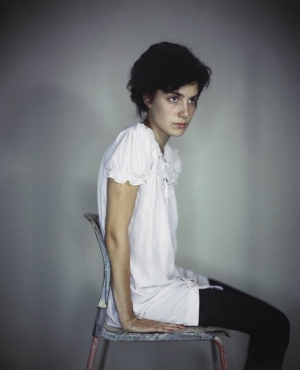
Union Gallery 57 Ewer Street SE1 0NR London Royaume-Uni
The works exhibited are rich in colour and detail, a product of a specific process whereby the photographs are made as singular objects. Learoyd utilises a unique photographic method to create large-scale life sized images with a specifically built camera. The camera captures the image without any interposing negative, transparency or intermediate material; rather light is directly focused by the camera onto a positive photographic paper. The images are therefore unique. The photographs are made and conceived as a whole, not as fragments or miniaturisations of objects and people. Whilst being made, the image is viewed by standing in the camera, uncorrected upside down and left to right, transient and realistic images of people on a white board on a black wall, the ultimate personal cinema, or mechanised camera obscura. The work shown is produced in a single room. Objects and people are brought to the camera and placed and arranged in front of the camera. Artless compositions and simple constructions belie complex compositional problems and hopelessly restrictive rules dictated by the physics of optics and light. Portraits, nudes and objects all share the same realistic treatment. Learoyd rejects the idea that his method is simplistic or shares a relationship with pinhole photography. Instead he considers the method he uses to be a natural step in search of the ultimate image, not only in its ability to create likeness, but in the object's ability to translate the intention of the maker. Sometimes technology, even in a technical medium is not the best solution. The subject matter chosen is not trying to fulfil an externalised cultural brief, but obviously holds resonance for the artist. Learoyd works outside the convention of a photographic sequence or series, but in a cohesive grouping of singular images. He has created a process that cuts like scan through anything or anyone placed before his camera.
The overriding feeling of ‘Inside a Camera’, this show of photographs, is of a macabre, enervating stillness. Partly, that’s due to the subject matter of his portrait, nude and object tableaux, with their curious balance of gothic-inspired imagery and austere, functionalist simplicity. A dead hare, for instance, is dynamically propped among concrete breeze blocks in a dreadful parody of vitality; in his portraits of androgynous young women, posed against a blank studio wall, their embroidered dresses and lace sleeves suggest a Victorian aesthetic of diffidence and repression.
The result is a sort of grotesque, exaggerated realism: larger-than-life portraits and still-lives which seem to revel in their hideous examination of detail, from the desiccated husks of a bouquet of wildflowers, to the flaccid carcass of a squid, with its glistening, unctuous sheen.
In the gallery’s final room, Learoyd turns his attention to the human nude, pitilessly depicting his models’ every imperfection: their pimples, scars and hairlips; the pallid contours of their flesh; the way they seem awkwardly to clutch themselves. And yet, for all this relentless, intimate scrutiny, what finally makes these photographs so gnawingly unsettling is the strange sensation of detachment and privacy – as if the models’ waxy skins are merely a type of covering, something they can hide behind: a kind of living death-mask.

